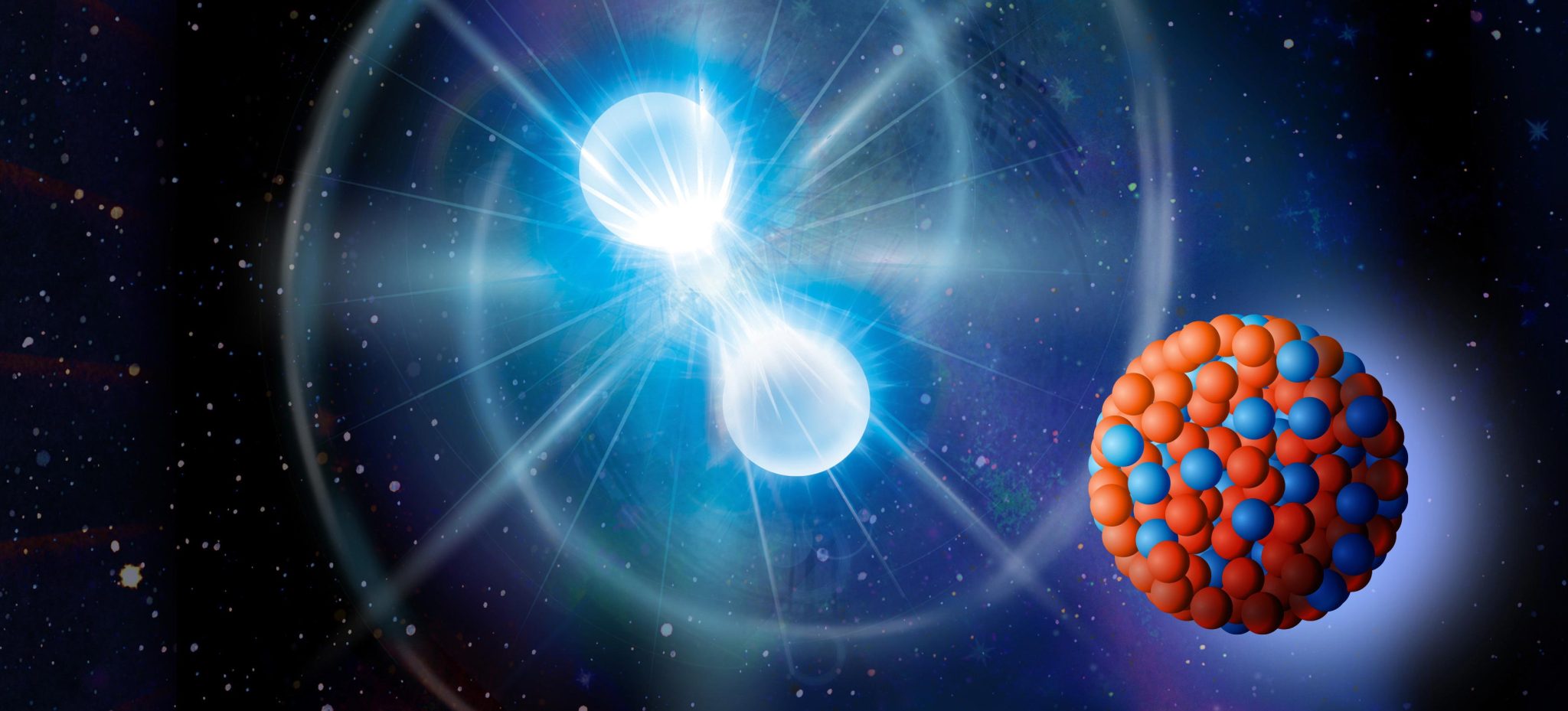
Wanneer een ster sterft, kan het gewelddadige einde leiden tot de geboorte van een neutronenster. Neutronensterren zijn de zwaarste in het universum – een theelepel van enkele kilometers van een hemellichaam weegt een miljard ton. Er is een onvoorstelbaar verschil in grootte tussen de atoomkern van isotoop 208 en een neutronenster, maar het is de natuurkunde zelf die hun eigenschappen grotendeels beschrijft. Nu hebben onderzoekers van Chalmers een nieuw rekenmodel ontwikkeld voor het bestuderen van de atoomkern van lood. De 126 neutronen (rood) in de kern vormen een buitenste schil die kan worden omschreven als een huid. Hoe dik de huid is, hangt samen met de sterke kracht. Door de dikte van de neutronenhuid te voorspellen, zou de kennis over hoe de sterke kracht werkt – in zowel atoomkernen als neutronensterren – kunnen toenemen. Krediet: JingChen | Chalmers University of Technology | In Strandqvist
Men denkt dat massieve neutronensterren die in de ruimte botsen, in staat zijn om edele metalen zoals goud en platina te vormen. Hoewel de eigenschappen van deze sterren een mysterie blijven, ligt het antwoord misschien onder de korst van een van de kleinste bouwstenen van de aarde – een atoomkern van lood. krijg kernel[{” attribute=””>atom to reveal the secrets of the strong force that governs the interior of neutron stars has proven difficult. Now a new computer model from Chalmers University of Technology in Sweden, can provide answers.
Chalmers researchers present a breakthrough in the calculation of the atomic nucleus of the heavy and stable element lead in a recently published article in the scientific journal Nature Physics.
The strong force plays the main role
Despite the immense size difference between a microscopic atomic nucleus and a neutron star several kilometers in size, it is essentially the same physics that governs their properties. The common denominator is the strong force that holds the particles – the protons and neutrons – together in an atomic nucleus. The same force also prevents a neutron star from collapsing. Although the strong force is fundamental in the universe, it is difficult to include it in computational models. This is especially true when it comes to heavy neutron-rich atomic nuclei such as lead. Therefore, scientists have wrestled with many unanswered questions in their challenging calculations.

Andreas Ekström, Associate Professor, Department of Physics, Chalmers University of Technology, Sweden. Credit: Chalmers University of Technology | Anna-Lena Lundqvist
A reliable way to make calculations
“To understand how the strong force works in neutron-rich matter, we need meaningful comparisons between theory and experiment. In addition to the observations made in laboratories and with telescopes, reliable theoretical simulations are therefore also needed. Our breakthrough means that we have been able to carry out such calculations for the heaviest stable element – lead,” says Andreas Ekström, one of the main authors of the article and Associate Professor at the Department of Physics at Chalmers.
The new computer model from Chalmers, developed together with colleagues in North America and England, now shows the way forward. It enables high-precision predictions of properties for the isotope* lead-208 and its so-called ‘neutron skin’.

Christian Forssén, Professor, Department of Physics, Chalmers University of Technology, Sweden. Credit: Chalmers University of Technology | Anna-Lena Lundqvist
The thickness of the skin matters
It is the 126 neutrons in the atomic nucleus that form an outer envelope, which can be described as a skin. How thick the skin is, is linked to the properties of the strong force. By predicting the thickness of the neutron skin, knowledge can increase about how the strong force works – both in atomic nuclei and in neutron stars.
“We predict that the neutron skin is surprisingly thin, which can provide new insights into the force between the neutrons. A groundbreaking aspect of our model is that it not only provides predictions, but also has the ability to assess theoretical margins of error. This is crucial for being able to make scientific progress,” says research leader Christian Forssén, Professor at the Department of Physics at Chalmers.
Model used for the spread of the coronavirus
To develop the new computational model, the researchers have combined theories with existing data from experimental studies. The complex calculations have then been combined with a statistical method previously used to simulate the possible spread of the coronavirus.
With the new model for lead, it is now possible to evaluate different assumptions about the strong force. The model also makes it possible to make predictions for other atomic nuclei, from the lightest to the heaviest.
The breakthrough could lead to much more precise models of, for example, neutron stars and increased knowledge of how these are formed.
“The goal for us is to gain a greater understanding of how the strong force behaves in both neutron stars and atomic nuclei. It takes the research one step closer to understanding how, for example, gold and other elements could be created in neutron stars – and at the end of the day it is about understanding the universe,” says Christian Forssén.
Notes
*Isotope: An isotope of an element is a variant with a specific number of neutrons. In this case, it is about the isotope lead-208 which has 126 neutrons (and 82 protons).
Reference: “Ab initio predictions link the neutron skin of 208Pb to nuclear forces” by Baishan Hu, Weiguang Jiang, Takayuki Miyagi, Zhonghao Sun, Andreas Ekström, Christian Forssén, Gaute Hagen, Jason D. Holt, Thomas Papenbrock, S. Ragnar Stroberg and Ian Vernon, 22 August 2022, Nature Physics.
DOI: 10.1038/s41567-022-01715-8
During the study, the researchers worked at Chalmers University of Technology in Sweden, Durham University in the UK, University of Washington, Oak Ridge National Laboratory, University of Tennessee and Argonne National Laboratory in the USA and TRIUMF and McGill University in Canada.
The research has been carried out using some of the world’s most powerful supercomputers. The Chalmers researchers have mainly been funded by the Swedish Research Council and the European Research Council.

“Gamedokter. Een zombiefanaat. Muziekstudio. Ninjacafé. Televisieliefhebber. Aardige fanatieke alcoholist.







More Stories
China is van plan het Tiangong-ruimtestation uit te breiden; Stel deze in op “Space Rule” omdat het ISS wordt uitgeschakeld
De Verenigde Staten detecteren het eerste geval van de H5N1-vogelgriep bij een varken, wat aanleiding geeft tot bezorgdheid voor de mens
NASA zal in 2025 de ruimtewandelingen aan boord van het internationale ruimtestation hervatten na een lek in het ruimtepak